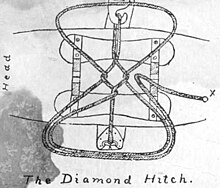Diamond hitch
| Single Diamond Hitch | |
|---|---|
 |
|
| Names | Single Diamond Hitch, diamond hitch |
| Category | Lashing |
| Origin | Western north-american continent |
| Typical use | packing, other |
| ABoK | 2088 |
The diamond hitch is a lashing technique used mainly in the field of equine packing, to secure a set of objects, for instance a pair of pack-bags, pack-boxes or other gear onto a base, for instance a pack saddle frame, in which case it requires the use of a lash cinch. In the general sense it requires the base to be equipped with at least two points of anchorage, and a rope which is used to lash the object down onto the base. There are two types of Diamond Hitches, a single, shown here, and a double diamond hitch which is not shown.
Designed and primarily used to secure a load onto a pack-saddle placed on the back of a pack-animal, usually a horse, mule or donkey (although other animals such as llamas or alpacas are regularly used), the diamond hitch can be used in a more general manner to secure anything "loose" to a base that is equipped with at least two anchor points. It can also be used effectively on the bed of a truck, or any other moving platform to which a load is to be secured.
In the diagram shown to the left, six points are used, but the top left, right, bottom left and right points can be ignored by simply "tucking" the rope beneath the load to be tied down, provided its shape and size allow, as is the case when the knot is used on a pack-saddle where those four extra points are simply the four corners of the pack to be tied down. The following description focuses on the way to tie a diamond hitch so as to secure a load onto a pack-saddle.
Tying a diamond hitch requires that a pack saddle be placed and loaded on the back of a pack animal. A lash cinch, made up of a piece of canvas or hide attached to a loop on one end and a hook on the other, is then placed under the animal's belly, generally (and according to the diagram above) with the loop on the animal's right and the hook on its left (the hook allows for easy release of the hitch without the need to feed the long rope through multiple rings).
A long length of rope is attached to the loop by means of a bowline or any other firm knot, and this rope is then passed through the loop once more leaving enough spare to reach over the animal and place the so-formed loop of rope in the hook on the other side. This double length of rope that is passed over the pack is then carefully twisted at least twice (the above diagram shows many more twists, but two are generally sufficient), with one twist being forced over towards the right side of the animal, while the other is left on its left, and then it is placed back in the hook, before tightening up the slack.
...
Wikipedia
